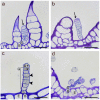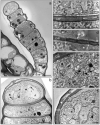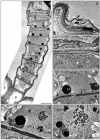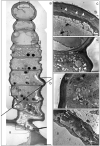Ultrastructural Alterations in Cells of Sunflower Linear Glandular Trichomes during Maturation
- PMID: 34451559
- PMCID: PMC8398616
- DOI: 10.3390/plants10081515
Ultrastructural Alterations in Cells of Sunflower Linear Glandular Trichomes during Maturation
Abstract
Sunflower and related taxa are known to possess a characteristic type of multicellular uniseriate trichome which produces sesquiterpenes and flavonoids of yet unknown function for this plant. Contrary to the metabolic profile, the cytological development and ultrastructural rearrangements during the biosynthetic activity of the trichome have not been studied in detail so far. Light, fluorescence and transmission electron microscopy were employed to investigate the functional structure of different trichome cells and their subcellular compartmentation in the pre-secretory, secretory and post-secretory phase. It was shown that the trichome was composed of four cell types, forming the trichome basis with a basal and a stalk cell, a variable number (mostly from five to eight) of barrel-shaped glandular cells and the tip consisting of a dome-shaped apical cell. Metabolic activity started at the trichome tip sometimes accompanied by the formation of small subcuticular cavities at the apical cell. Subsequently, metabolic activity progressed downwards in the upper glandular cells. Cells involved in the secretory process showed disintegration of the subcellular compartments and lost vitality in parallel to deposition of fluorescent and brownish metabolites. The subcuticular cavities usually collapsed in the early secretory stage, whereas the colored depositions remained in cells of senescent hairs.
Keywords: Helianthus annuus; flavonoids; glands; terpenes; trichome cytology.
Conflict of interest statement
The authors declare no conflict of interests.
Figures





References
-
- Werker E. Trichome diversity and development. Adv. Bot. Res. 2000;31:1–35. doi: 10.1016/s0065-2296(00)31005-9. - DOI
-
- Muravnik L.E. The structural peculiarities of the leaf glandular trichomes: A review. In: Ramawat K.G., Ekiert H.M., Goyal S., editors. Plant Cell and Tissue Differentiation and Secondary Metabolites, Reference Series in Phytochemistry. Springer Nature; Cham, Switzerland: 2020. pp. 1–34. - DOI
LinkOut - more resources
Full Text Sources

